Why This Year’s Baja 1000 May Be the Fastest Edition Yet
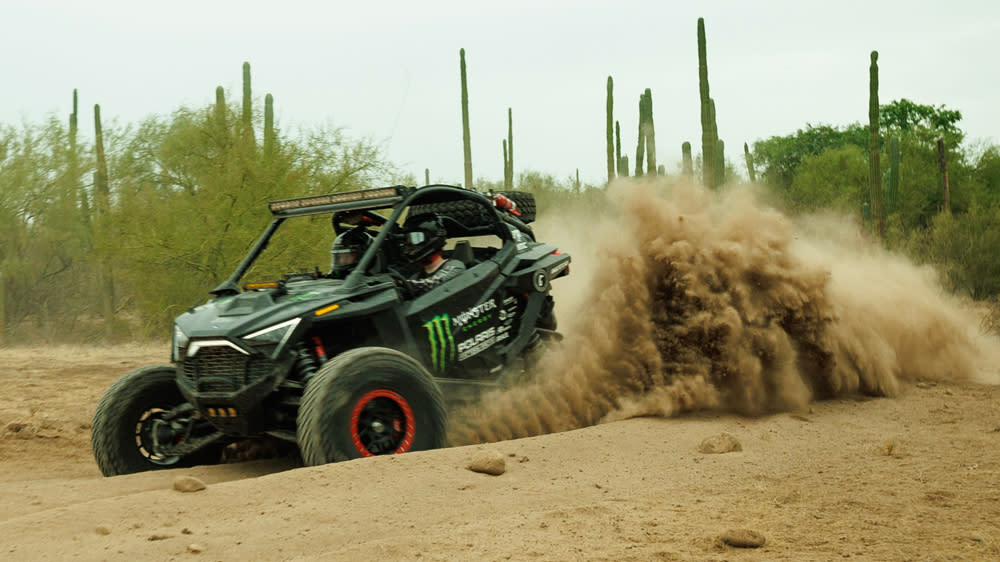
- Oops!Something went wrong.Please try again later.
This year’s Baja 1000 will be one for the record books. That’s because, for the first time ever in the iconic race’s five-decade-plus history, the course will run from the south to the north in what’s been dubbed a “reverse peninsula run.” By contrast, for most years, the route follows a loop that starts and ends in Ensenada, with total distances in the 800 to 1000-mile range. Then every three years (or so), a normal peninsula run goes from Ensenada to La Paz.
This year’s route from La Paz to Ensenada has never been done before in the Baja 1000, and the total mileage adds up to 1,310 miles. But the southern end of the peninsula also just took the brunt of Hurricane Norma, which made landfall as a Category 1 storm and dumped an enormous amount of rain onto the desert, completely changing the radical terrain.
More from Robb Report
Here's Why the New Polaris Xpedition UTV Is an Off-Roading Game-Changer
IWC Is Auctioning Off 4 Limited-Edition Pilot's Watches-After They Travel to Space
Meet Academy, a New Menswear Brand Remixing Prep-School Staples for Grown Ups
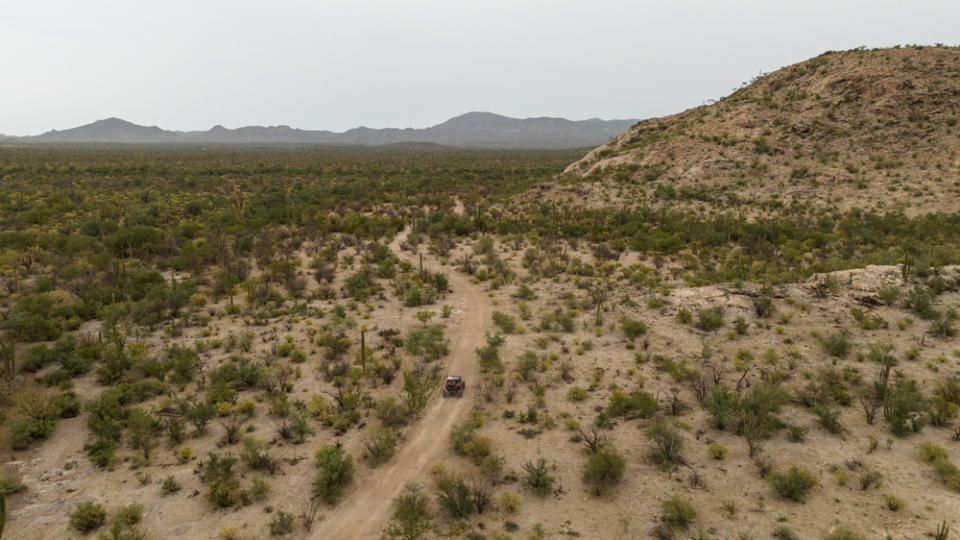
To get a feel for what racers might experience during this reverse-peninsula iteration, Polaris invited me to pre-run in Baja California Sur with Casey Currie, who has won the Baja 1000 three times and the Baja 500 once. But this was no ride-along, as I was allowed to do the driving myself—at absolute breakneck pace—in a stock RZR Pro R side-by-side.
We flew into Loreto, a small town nestled between the mountains and the Sea of Cortez on Baja’s eastern coast. I chose a window seat on the flight hoping to catch some glimpses of the beautiful beaches, desolate desert, and stunning mountains as we traveled southeast from Los Angeles. But the landscape turned greener and greener the further we flew, a far cry from the dry and dusty moonscapes I witnessed last year up north near Ensenada.
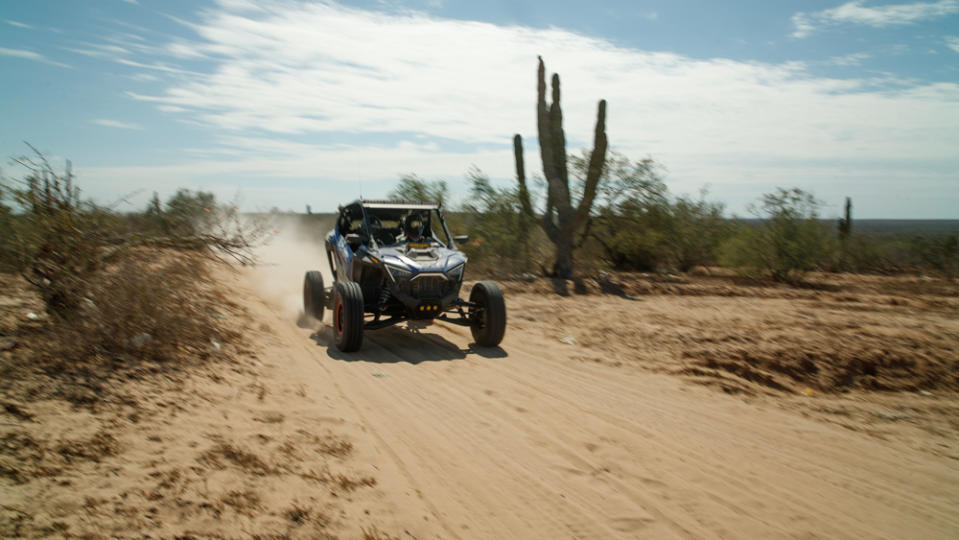
The next morning started early, with a couple of hours on asphalt until we reached race mile 130. But even the public roads surprised me, smooth and freshly paved throughout our liaison to where we turned into the dirt for the first time. I threw on a helmet, goggles, and gloves, then strapped into a RZR Pro R as we headed out onto a series of incredibly straight dirt tracks flanked by Ocotillo and Saguaro cacti, juniper bushes, and the occasional herd of cattle grazing in wide open pastures.
On this kind of terrain, the RZR Pro R absolutely gobbles up mileage, massive Fox Live Valve shocks absorbing smaller whoops and even the occasional four-wheel jump with ease. The team flew along at full throttle for almost all of the first couple of hours. When we stopped for gas, Currie made sure to remind everyone that this was not the norm.
“Almost no racer, from trophy truck to UTV, has ever gotten to drive the most epic part of Baja during the day in perfect conditions, because the race course has always been driven down and now we’re driving up,” he explained, “We’re driving on the backside of the whoops . . . it’s smoother no matter what, especially in a Pro R going 75, 80 mph.”
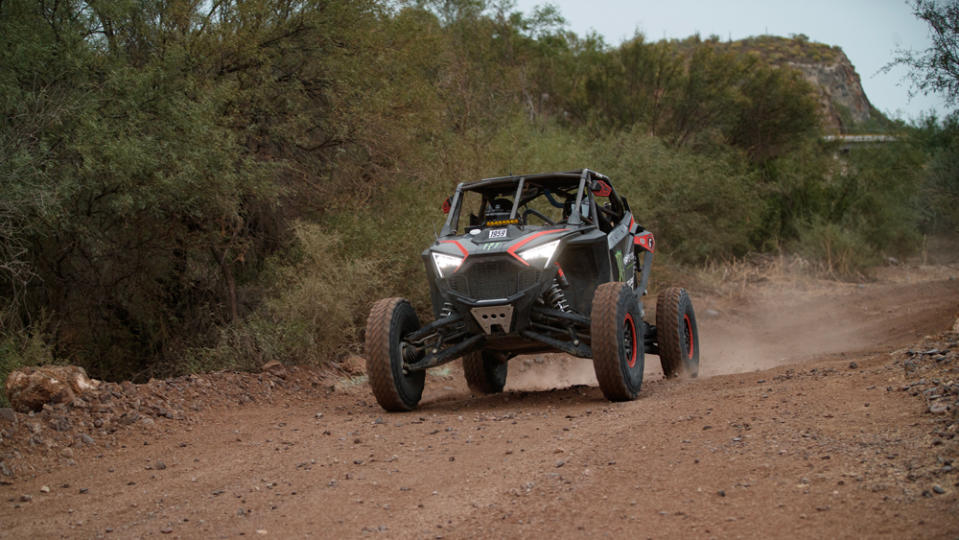
The racecourse turned subtly northwest, providing a brief respite from triple-digit temperatures, with a hint of ocean breeze rolling in off the Pacific as our map on the Polaris Ride Command screen showed blue to our left. We skirted along the coast for maybe half an hour, before turning back eastward to refuel in the small town of Ciudad Insurgentes.
After a few more miles on asphalt, we cranked a hard right into a long uphill wash that turned rockier and hotter the further we drove. The cool spray of shallow river crossings broke the spell, as I focused on missing any hidden rocks that might puncture a tire or damage suspension components. At the top of the climb sat a town nestled into picturesque cliffsides, which Jesuit priests in the 1600s deemed the perfect place to establish the Misión San Francisco Javier de Viggé-Biaundó. A stone church surrounded by date palms and olive trees, the mission hosts an elaborate gold altar and reportedly, nearby, the first olive tree ever planted in the “new” world.
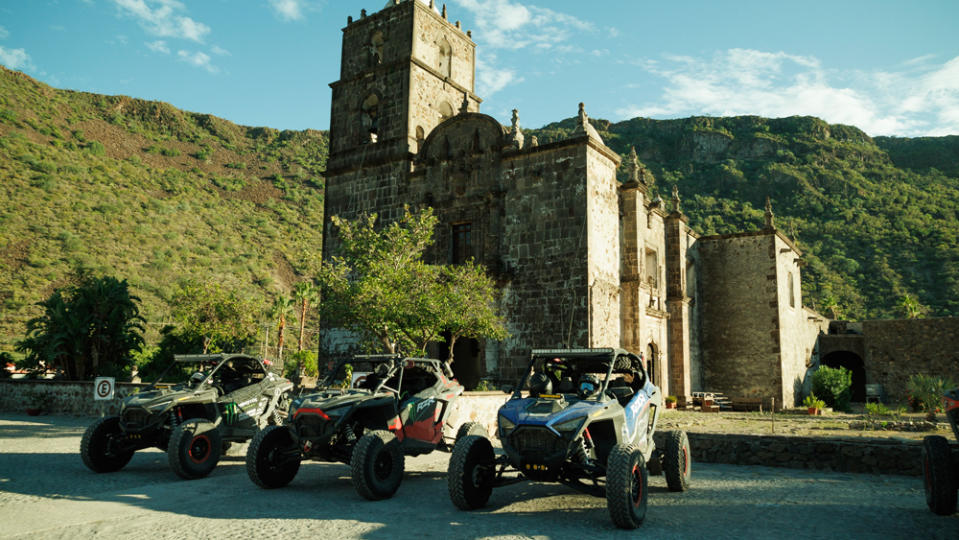
By now, the sun began to set over the verdant cliffs, so we blasted down a few miles of paved twists, then into a wash that took us straight back to Loreto, where welcome showers to rinse off the accumulated dirt were followed by ice-cold margaritas by the pool and ribeye dinners at a local steakhouse. We’d covered 210 miles, mostly at top speed but with the occasional stop to capture photographs and stay hydrated. But our second day would deliver much more of the quintessential landscape that makes racing in Baja so challenging.
Northward out of Loreto, the hills tightened in and rocky washes transitioned into smaller sections of technical climbing interspersed with silt flats. The RZRs hustled along, absorbing even more punishment than the day before with equal aplomb. My confidence was bolstered not only with regards to the chassis but also the Nitto Trail Grappler SxS tires’ ability to seemingly handle anything that Baja might throw at us. I whipped in more countersteer, picking up pace in the corners and trying to simply blast through every patch of silt as quickly as possible, dirt flying up and over the roof more than a few times.
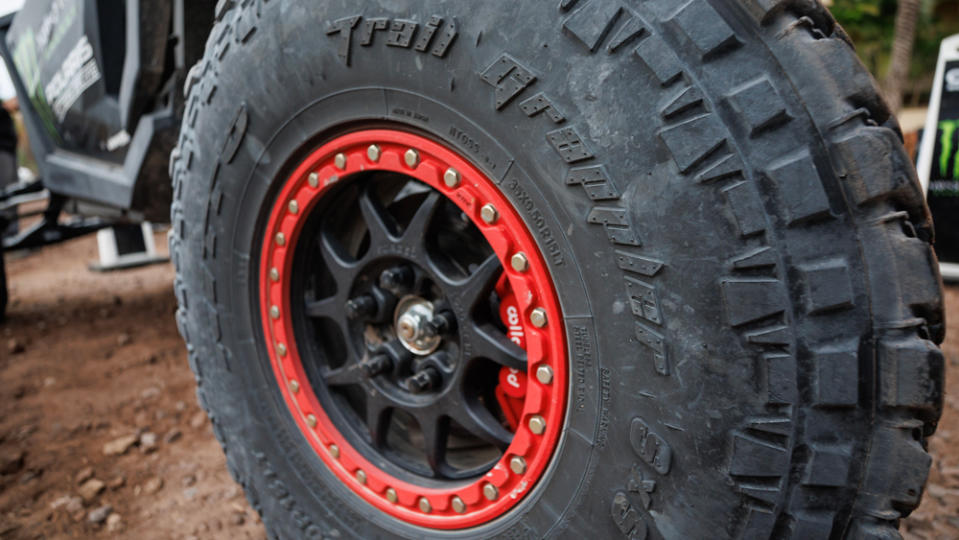
Then I rode with Currie in his race-prepped RZR, with a roll cage and 35-inch tires versus the stock 33-inchers. Watching a pro work always provides a solid lesson, as we slalomed through the saguaros and launched over whoops without lifting. But mostly I found his confidence in the tires to be the most impressive aspect of the drive, as his eyes could then focus much further along and prepare for higher-speed cornering and later braking than I had ever thought wise.
On this portion of the track, other teams pre-running in purpose-built pickup trucks and homemade rigs also whipped by whenever we stopped. But mostly we spotted other side-by-sides, which have become the favorite for even trophy-truck drivers hoping to practice without blowing a large portion of their budgets for the million-dollar-plus race builds.
“The capability and reliability of these vehicles is insane; you have teams that have millions of dollars and they’re pre-running in a Pro R,” Currie told me at the end of the day. “All these big teams are getting in these UTVs and coming down, putting tires and wheels on them, and driving them thousands and thousands of miles. We didn’t change a single tire, we didn’t change a single belt, we didn’t touch an air filter. We just drove.”
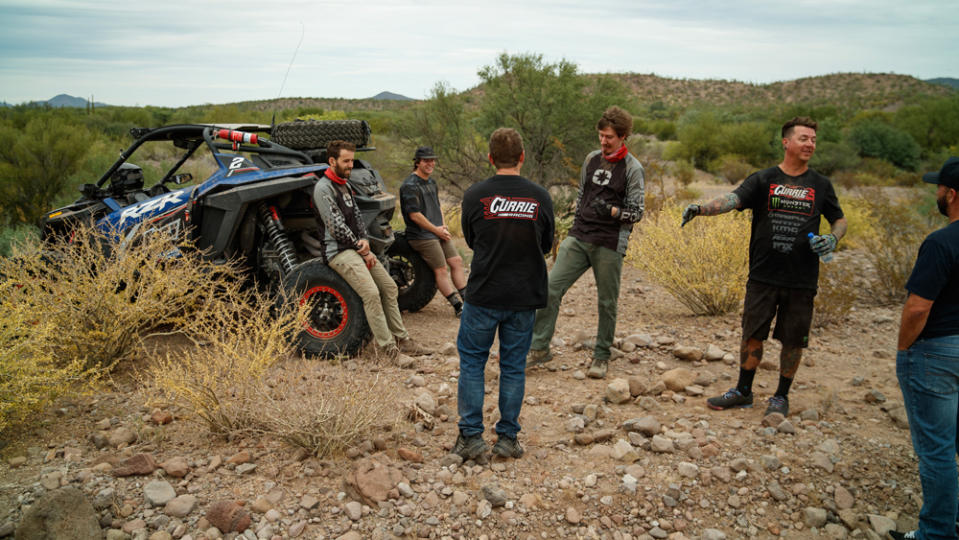
The day ended as a rainstorm rolled in from the west, pelting us with heavy drops on the drive south into Loreto. All told, we had covered around 450 hard miles, including more than 320 miles of the actual Baja 1000. My mind balked at the thought of racers sitting at the start line on November 16, all hoping to complete the entire 1,310 miles in one shot.
The best part, though, is that anyone, not just race teams, can come down to pre-run Baja before any of SCORE or NORRA’s 250, 400, 500, and 1000-mile races. The organizations pay fees and ranchers to open gates that might be closed or land that might be off-limits the rest of the year.
“Here we are, four RZRs, 12 people, and we came down and we ripped for 450 miles. We didn’t run into a single gate, no upset ranchers, we didn’t do anything illegal,” Currie said. “This is the chance to come down here and see it all before the racecourse is chewed up from trophy trucks and all the other big classes.”
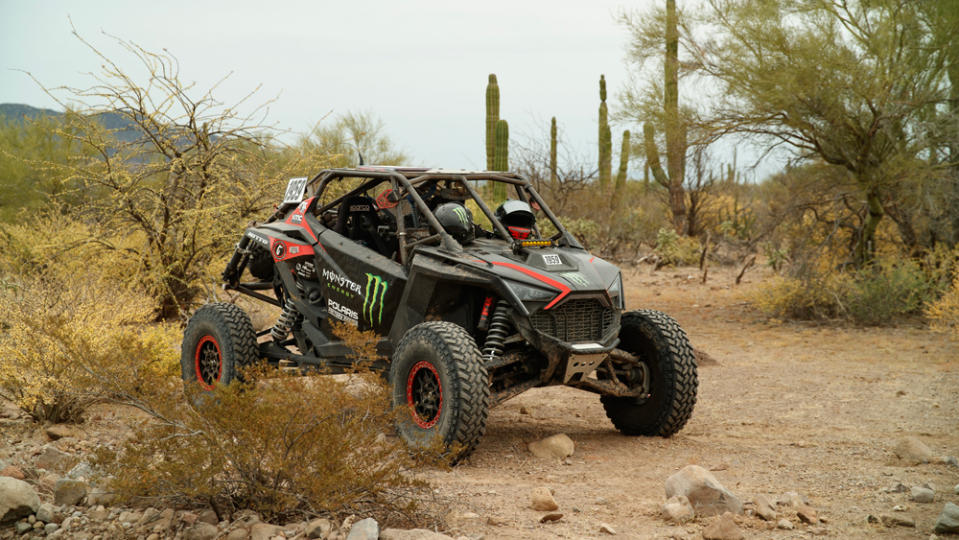
Yet as I learned early on in my pre-running adventure, you need to know the rules. The main safety admonitions are to never drive backward on the course, and never stop on the course, because another vehicle might be ripping by at top speed 30 seconds later. But otherwise, the spirit of competition that defines the actual race is largely preceded by camaraderie as teams talk strategy, terrain, and timing throughout the process of pre-running.
Despite the rare route layout and brutal overall distance, the 2023 Baja 1000 might just end up as one of the fastest editions of the famed off-road contest to date because of the fresh, smooth terrain. Regardless, it will undoubtedly provide the perfect setting to live out archetypal desert-racing dreams.
Best of Robb Report
Sign up for Robb Report's Newsletter. For the latest news, follow us on Facebook, Twitter, and Instagram.

